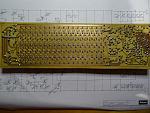In my previous post I presented an idea spawned from a very bad place, primarily boredom and probably too much alcohol. Plane trips from Australia do that...
The Amplifier of 100 Transistors was the result.
Between that posting and this a few things have happened. I finished the design - adding extra decoupling and 100 Ohm base resistors to all 104 output devices. I did this because I sincerely thought I was building more of an RF oscillator than amplifier.
And I built it.
And I got it working.
This is the beast from the back before I loaded the "output devices":

Note the ludicrous number of emitter and base resistors! Half way through I concluded that I was bonkers, and wasting several days hand building a complete folly.
Then again, even with the thing running, it is still a folly!
With the output devices loaded....
















